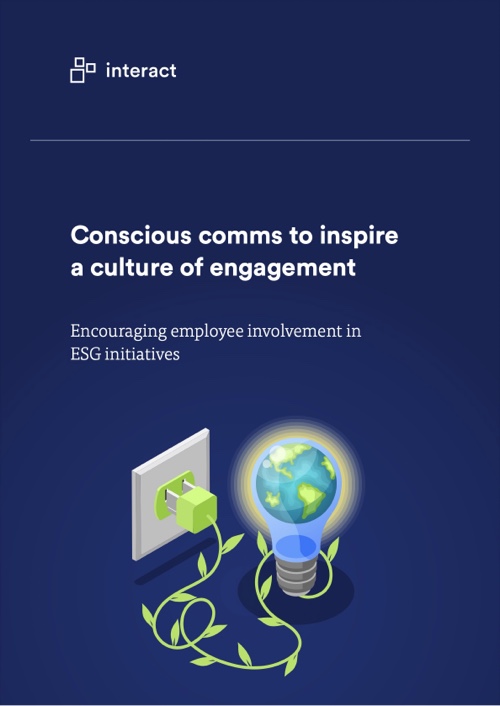The arrival of Earth Day 2022 gives us all an opportunity to consider how well our organizations are promoting green initiatives and ESG engagement internally. For ESG commitments to thrive, employees need to participate. This article explores why ESG engagement matters in internal comms, the barriers that can prevent employee participation, and how you can create an ESG communications strategy that inspires action.
Environmental, Social, and Governance (ESG) commitments matter more than ever but they are also creating an internal communication challenge within businesses. Despite a desire to broadcast the good things companies are doing with Corporate Social Responsibility (CSR) in mind, nearly half of CEOs say they are under pressure to explain their organization’s ESG practices, and 43% say they struggle to tell a compelling ESG story.
Your FREE guide to ESG communications
The question then is how can companies do better when it comes to communicating ESG and engaging employees internally? After all, without ESG engagement from your people, well-intentioned green initiatives can all too easily appear as window dressing; empty gestures that can make your organization look like it wants to appear to be doing good, without really making much impact.
With recent accusations of greenwashing aimed at high-profile brands, it’s important to ensure there is action behind the messaging your organization puts out around environmental issues.
What are the barriers to ESG engagement?

Common barriers to ESG engagement can include:
- Busy employees are more likely to skip internal comms that don’t command their attention or give them a sense of urgency when they are focusing on pressing tasks.
- Some employees may feel that they lack the time, skills, or money to get involved in initiatives. This is a perception issue that can be overcome with a clear and straightforward explanation of what’s required in your internal comms around the initiative.
- Proximity bias can be a common issue in organizations with remote workers who may feel excluded from in-person and group activities. This requires organizations to provide a range of ideas and options that allow dispersed employees to take part in ways that work for them.
Your FREE guide to ESG communications
- Employees with no previous experience in ESG engagement could be less likely to participate.
- Social anxiety can prevent some employees from engaging in group activities.
- Top-down internal comms can be less effective for some segments of the workforce, such as frontline workers who are typically more receptive to horizontal comms from co-workers. This can make them feel more inspired by the actions and enthusiasm of others in the organization rather than feeling pushed to take part by leadership.
How to drive ESG engagement through internal comms

Internal comms can have a powerful influence on ESG engagement, but only when the communications strategy has been carefully considered. You can ensure your ESG comms are driving engagement and participation by asking a series of questions that will help to identify where the communications strategy may be failing, and what corrective actions you can take.
Four key questions to ask about your ESG comms strategy:
1. Is your ESG communications strategy reaching every employee?

Internal communicators need to ensure they’re utilizing the right mix of channels and reaching employees through the right mediums, at the right times. For example, frontline workers who can’t be reached easily via email will be better reached through digital signage. Where urgency is required, they can be also be encouraged to read the content through a push notification through your employee app. On the other hand, many desk workers will now be more accustomed to platforms such as Teams and Slack over email. Messages deployed via these channels need to be scheduled to reach them at the best time for engagement, so your ESG comms don’t get lost in the noise.
Reaching every employee in this way requires access to an employee experience platform (EXP) that provides integrations with other third-party digital workplace tools (such as Teams and Slack). This should also enable multichannel communications to be scheduled and distributed to different workgroups and personas through those channels, alongside traditional channels such as email, SMS, digital signage, and your intranet homepage.
2. Are your comms being tailored for specific audiences?

Let’s consider those employees who are known to shy away from participating, for example; are they being re-targeted with messaging that is softer, or more persuasive in subtle ways? A multichannel EXP that provides in-depth analytics that are easy to dive into and digest will provide communicators with granular details such as which specific workgroups or individuals are less receptive to each campaign.
Your FREE guide to ESG communications
Overcoming proximity bias also requires different options for different working patterns. For example, being able to publish to channels remote workers are more receptive to, and scheduling ESG comms to arrive at the optimum time of day (or night, depending on shift pattern) for maximum engagement. This is where granular analytics can help you to understand how each of your remote workers engages with your ESG comms, and how you can improve their experience as recipients, and ultimately win their attention.
3. Are you facilitating two-way conversations?

Are you giving recipients of your ESG comms opportunities to ask questions, or contribute ideas? If so, is it clear how and where they can ask/engage with the right people? You should consider providing clear channels for employees to ask for additional information, and the same goes for gathering feedback from those who have taken part in an environmental initiative. Information on who to contact and how to contact them should be included in your ESG comms, with a link to a dedicated homepage for all things ESG on your intranet so employees can easily access this information and other details at any time.
4. Are you shouting about the benefits and broadcasting your achievements?

Involvement in ESG represents an opportunity to help make the world a better place. Who wouldn’t want to be part of that? Whether you’re simply letting your employees know they’ll be contributing to positive change, or you’re incentivizing them to take part in some way, your ESG comms need to drive those benefits home.
Another great way to inspire ESG engagement is to broadcast the achievements of previous environmental initiatives that have taken place within your organization. This is where horizontal comms can help as part of your overall communications strategy. We mentioned earlier that some employees can be more receptive to communications that aren’t necessarily coming from the internal comms team or leadership, so encouraging co-workers who have taken part in ESG initiatives to share their experiences and shout about their achievements is another way to get people motivated.
Your FREE guide to ESG communications
The challenge in encouraging horizontal comms is that those who have exciting stories to tell may not necessarily be great writers or communicators. Fortunately, the rise of AI-driven features in leading internal communications platforms can help anyone create eloquent and engaging content that resonates. Any modern intranet software, for example, should feature an advanced CMS editor that can provide AI-driven grammar and readability recommendations to help employees write compelling stories. The editor should also provide easy-to-edit content templates, and simple drag-and-drop building blocks to create visually appealing comms from scratch. These features will help to ensure your ESG comms are engaging as possible, no matter who the author is.
Reducing ESG risk in your organization
It’s clear that ESG is important. According to Gartner, 85% of investors considered ESG factors in their investments in 2020. So, if your organization is looking for financial backing now or in the future, potential investors will be looking at your ESG credentials. As McKinsey points out too, ESG also matters to your employees. Millennial and Gen Z workers in particular prefer meaningful work with employers that are tackling environmental issues, so making sure they are aware of your initiatives and know how they can participate in ESG engagement is critical.
However, low internal engagement with your initiatives can suggest to external and internal audiences that there is a lack of action behind your organization’s words around environmental issues. Engagement is the key to authenticity when it comes to your organization’s ESG story, and it helps to reduce the risks of losing out on talent, investment, and business through improved public perception. With the right communications strategy, supported with the right tools and features, you can ensure your organization has a compelling narrative to share externally when it comes to ESG.


